This post may contain affiliate links. Please read our disclosure policy.
This is a lighter version of the popular Japanese souffle cheesecake using nutritious high-protein Greek yogurt with some chocolate sprinkles. It has a nice fluffy and airy texture and a taste like Japanese souffle cheesecake, but much healthier and nutritious.
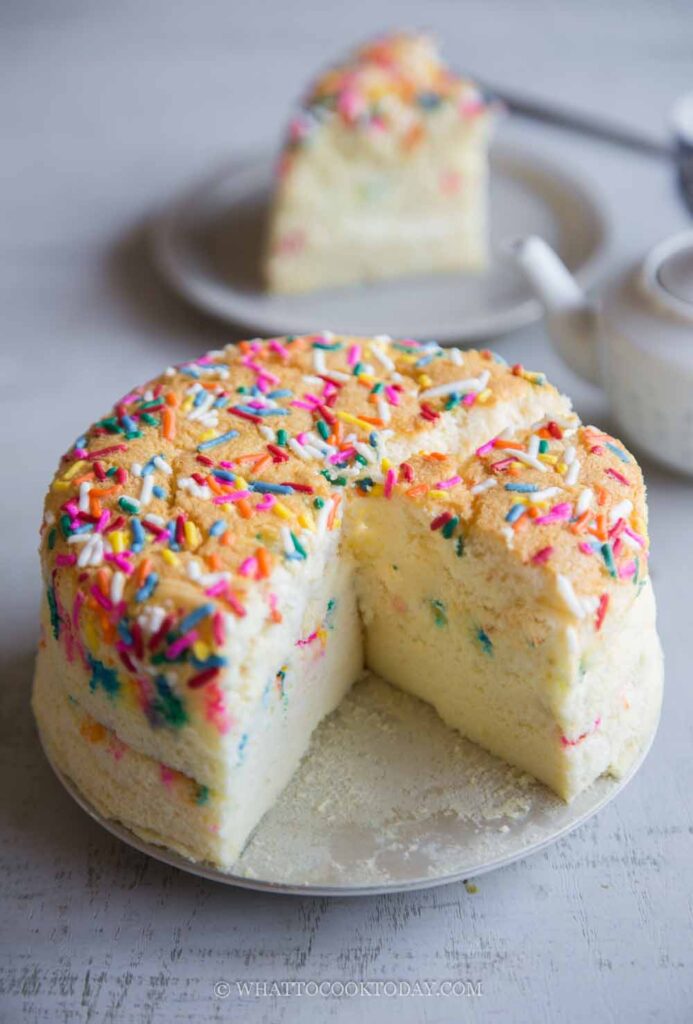
What is yogurt souffle cake?
It’s a unique variation of the popular Japanese souffle cheesecake that is known for its light and fluffy texture, which is reminiscent of a soufflé. Instead of a cream cheese, a creamy and protein-packed Greek yogurt is used to prepare yogurt souffle cake. I personally call this a “faux” Japanese souffle cheesecake because it tastes so much like one and the texture is so light and fluffy.
Will the cake taste sour because of the Greek yogurt?
The cake has a slight tang, but it’s not overly sour if you are concern about that. I feel that it complements well with the richness the whole-milk Greek yogurt and eggs provide and balanced by the light sweetness.
Ingredients and substitutions
1. Whole-milk Greek yogurt
I highly recommend using whole-milk Greek yogurt for a smooth and rich texture. I have tried it with non-fat plain Greek yogurt, and the texture is not as creamy and feels drier. You can also use lightly sweetened and flavored whole-milk Greek yogurt if you don’t want the slightest tangyness at all in your cake. The cake will taste sweeter and has flavor of whatever Greek yogurt flavor you use
2. Eggs
I use grade A large eggs, which usually weigh about 60-62 grams with the shell.
3. Cake flour
Cake flour is used in very small amount and it is added to give the cake a light and fluffy texture
4. Cornstarch
Cornstarch also give the cake a light and fluffy texture and also act as a binder
5. Sugar
The sugar is needed to whip the meringue to the correct consistency. The meringue is responsible for the fluffiness of souffle-type cake. I usually use granulated sugar, but caster sugar works too
6. Vanilla extract
This adds a nice flavor and if you are sensitive to the smell or taste of eggs, the vanilla extracts helps in that department. Feel free to use other extract you want, such as almond extract, coconut extract, etc.
7. Lemon juice
The acid is added to whip the egg white meringue. You can use vinegar or cream of tartar too
8. Salt
A pinch of salt help to round up the overall flavor. You don’t need much, but a pinch is what it takes. I usually use fine sea salt
Light and Fluffy Yogurt Souffle Cake
Ingredients
- 60 g egg yolks room temperature, from 3-4 large egg yolks
- 100 g plain whole-milk Greek yogurt room temperature
- ½ tsp vanilla extract
- 30 g cake flour
- 15 g cornstarch
- ⅛ tsp fine sea salt
Egg white meringue:
- 115 g egg whites room temperature, from 3-4 large egg whites
- 70 g sugar
- ½ tsp lemon juice or vinegar or 1/2 tsp cream of tartar
Topping: (optional)
Instructions
- I highly recommend that you weigh the ingredients with digital kitchen scale and please don't use the cup/tablespoon measurement eventhough I provided one. It's not as accurate. Precision is extremely important especially in this difficult-to-bake cake.
- If you want to double the recipe, you can use 9-inch round pan or 8-inch square pan
Things to prepare before you start preparing the cake batter:
- My oven is a conventional setting with bottom heat no fan. Preheat oven at 285 F (140 C). If you have top and bottom heat oven, you can set it to 250 F (120 C). Please note that, the temperature is just for reference, it may or may not work for your oven. You may need to do some adjustments
- Let the Greek yogurt sit on the counter to let it come to a room temperature
- Separate the egg whites from the yolks. Let them come to room temperature while you prepare other things
Prepare the cake pan:
- You will need to use two-three pans in this recipe. I use a 6-inch loose-bottom round pan to bake the cake and another 7-inch round pan or any size pan you have that can fit in the 6-inch pan to prevent water from sipping through the loose-bottom pan. Then an 8 or 9-inch pan for the water bath. Line the side of the pan with a parchment paper too, with the paper extending about 1-inch extra above the rim of the pan
- You can also use just two pans and wrap the 6-inch loose-bottom round pan with triple layers of aluminum foil to prevent water from sipping through the loose-bottom pan. Thne use a 8-inch pan for the water bath. I found that using this method, somehow water still manage to leak into the pan
- If you don't have a loose-bottom pan, line the bottom with a parchment paper. Line the side of the pan with a parchment paper too, with the paper extending about 1 inch extra above the top of the pan. I find it easier to remove the cake when I line the side with a parchment paper
- If you use a square pan, line with a parchment paper on the bottom and the sides by overlapping the paper horizontally and vertically
Prepare the water bath:
- Fill up the larger pan with some water, about 1-inch high and I put this at the lowest rack, where I will be baking the cake. Let the pan with water preheat together with the oven
Prepare the cake batter:
- Put egg yolks, Greek yogurt, and vanilla extract in a mixing bowl and whisk to combine. Sift in cake flour, cornstarch, and salt into the mixture. Whisk to combine
Whip the meringue:
- Start whipping the meringue at medium speed (speed 4 on KA) until foamy. Add the lemon juice and beat for another minute, then gradually add 1/3 of sugar and let it beat for another minute before adding another 1/3 until you run out. Increase the speed to 6 and whip until the mixture form a firm peak. When you lift the meringue up it will hold its shape but with slight bent on the tip. Stop beating
Fold meringue:
- Fold 1/3 of meringue into the batter using a whisk. Swipe down like a "J" motion and then fold over. You can be a bit more vigorous with this first round of folding to combine the batter and the meringue. Continue with the next 1/3 using the same "J" motion but be gentle and don't take too long to combine either. Continue with the last 1/3. Then switch to using a spatula with the same "J" motion and scrape the bottom of the bowl to make sure everything is folded in evenly. Sometimes some batter got stuck at the bottom of the bowl
- You shouldn't see anymore white meringue and the combined batter is silky smooth, light, airy, and tripled in size. Pour half of the batter into the pan. Use a skewer or chopstick to go round and round the batter to pop any air bubbles inside the batter. Sprinkle with some chocolate sprinkles. Then gently pour the rest of the batter on top. Use a skewer to go round and round the top portion of the batter, trying not to disturb the chocolate sprinkle layer beneath it. Top with chocolate sprinkle on the surface. Then tap the pan on the countertop 2-3 times to pop more air bubbles
Bake the cake:
- Carefully put this pan inside the larger pan. The water inside of the pan should be simmering as it has been preheated. Close the door and set timer to 20 minutes
- Increase temperature to 170 C (330 F). For top and bottom heat oven adjust to 150 F. Set the timer to 15 minutes. You don't need to wait until it reaches the newly set temperature to start the timer. I kept monitoring its progress during this 15 minutes. This is the time where the cake starts to rise. If you start seeing some cracks are about to form, the oven is too hot. Open the oven door for about 10 seconds to release some pressure and close it back. If during that 15 minutes the cake still has a smooth top, then there's no need to open the oven door
- Lower temperature to 120 C (250 F). For top and bottom heat oven adjust to 110 C (230 F). Open the oven door for 10 seconds and then gently close it back and set the timer to 60 minutes. You may not need 60 minutes. You can start checking at around 40 minutes
- Increase temperature to 150 C (300 F) and bake for another 10 minutes. This part is to brown the top of the cake. If yours is already brown, you can skip this part. Mine was still pretty pale at the end of the 50 minutes of baking. So I need a total of about 100 minutes to bake this cake. It could be different with your oven
Cooling down:
- Turn off the oven and open the door for 10 seconds and then close it back and let the cake cools in the oven for 10 minutes
- Remove from the oven and let it sits on the counter for another 10 minutes. I started to unmould the cake by pushing up the cake (I use a loose-bottom pan). If you use a regular pan, trim off the excess paper on top and then invert the cake upside down on a cooling rack or a plate. Peel off the parchment paper at the bottom and the side. Flip the cake back onto a serving platter and let it cools down completely
- There will be a small amount of shrinkage, about 1/2 inch, in my case, if the cake is perfectly baked. When you gently pat the cake on the side while it's still warm, the cake will jiggle. Once it cools down completely and set, it won't jiggle anymore and it is normal
Serving:
- This cake needs to be chilled before serving for the best taste and texture. Let the cake cool down completely at room temperature and then put in the fridge for at least 8 hours before serving
Storage:
- You can store the cake in the fridge for about 3-4 days in an air-tight container. The chilled yogurt souffle cake has a light yet dense and creamy texture. I don't recommend freezing the cake as the texture will suffer if you do so
RECOMMEDED TOOLS
*Nutrition facts are just estimates and calculated using online tools*

Tips for success:
1. Weigh the ingredients
I highly recommend that you weigh the ingredients with digital kitchen scale and please don’t use the cup/tablespoon measurement eventhough I provided one. It’s not as accurate. Precision is extremely important especially in this difficult-to-bake cake.
3. Room temperature ingredients
Let the Greek yogurt and eggs come to a room temperature
4. Whip the meringue to the correct consistency
The meringue should be whipped to a firm peak, but not too stiff that the texture of the egg white turns dry and separate
How to bake yogurt souffle cake
1. If you want to double the recipe, you can use 9-inch round pan or 8-inch square pan
2. My oven is a conventional setting with bottom heat no fan. Preheat oven at 285 F (140 C). If you have top and bottom heat oven, you can set it to 250 F (120 C). Please note that, the temperature is just for reference, it may or may not work for your oven. You may need to do some adjustments
3. You will need to use two-three pans in this recipe. I use a 6-inch loose-bottom round pan to bake the cake and another 7-inch round pan or any size pan you have that can fit in the 6-inch pan to prevent water from sipping through the loose-bottom pan. Then an 8 or 9-inch pan for the water bath. 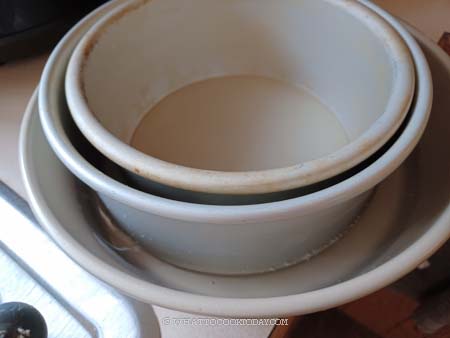
4. You can also use just two pans and wrap the 6-inch loose-bottom round pan with triple layers of aluminum foil to prevent water from sipping through the loose-bottom pan. Thne use a 8-inch pan for the water bath. I found that using this method, somehow water still manage to leak into the pan Line the side of the pan with a parchment paper too, with the paper extending about 1-inch extra above the rim of the pan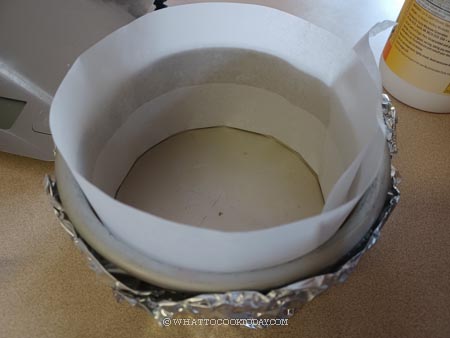
5. Fill up the larger pan with some water, about 1-inch high and I put this at the lowest rack, where I will be baking the cake. Let the pan with water preheat together with the oven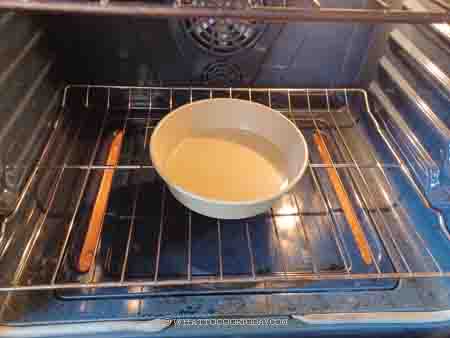
6. Put egg yolks, Greek yogurt, and vanilla extract in a mixing bowl and whisk to combine. 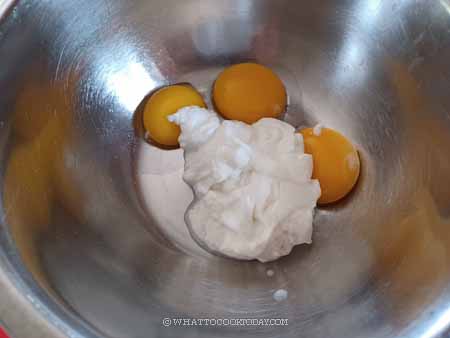
7. Sift in cake flour, cornstarch, and salt into the mixture. Whisk to combine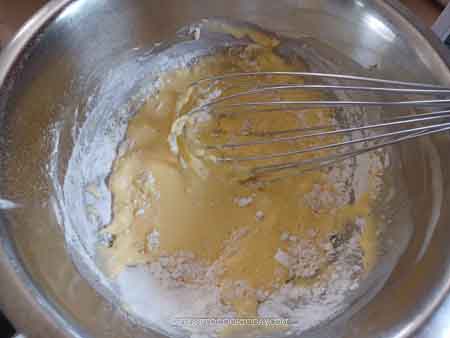
8. Start whipping the meringue at medium speed (speed 4 on KA) until foamy. Add the lemon juice and beat for another minute, then gradually add 1/3 of sugar and let it beat for another minute before adding another 1/3 until you run out. Increase the speed to 6 and whip until the mixture form a firm peak. When you lift the meringue up it will hold its shape but with slight bent on the tip. Stop beating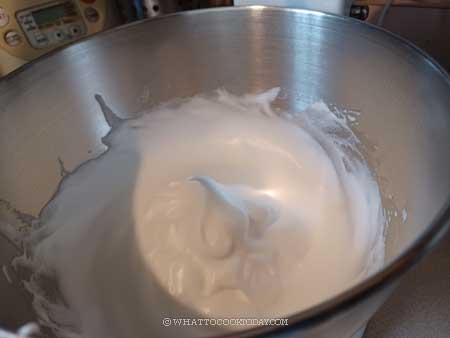
9. Fold 1/3 of meringue into the batter using a whisk. Swipe down like a “J” motion and then fold over. You can be a bit more vigorous with this first round of folding to combine the batter and the meringue. Continue with the next 1/3 using the same “J” motion but be gentle and don’t take too long to combine either. 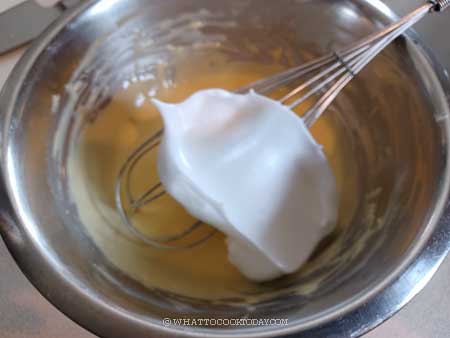
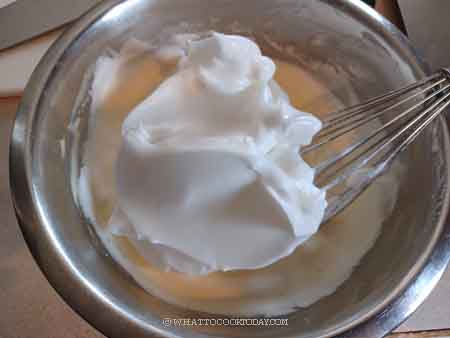
10. Continue with the last 1/3. Then switch to using a spatula with the same “J” motion and scrape the bottom of the bowl to make sure everything is folded in evenly. Sometimes some batter got stuck at the bottom of the bowl. You shouldn’t see anymore white meringue and the combined batter is silky smooth, light, airy, and tripled in size.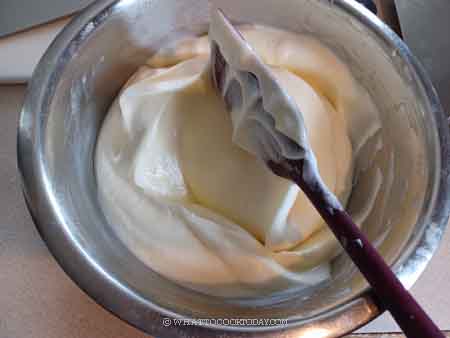
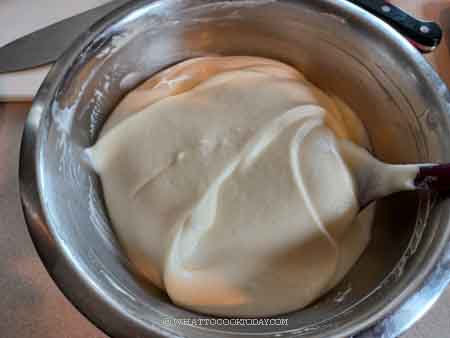
11. Pour half of the batter into the pan. Use a skewer or chopstick to go round and round the batter to pop any air bubbles inside the batter. Sprinkle with some chocolate sprinkles. 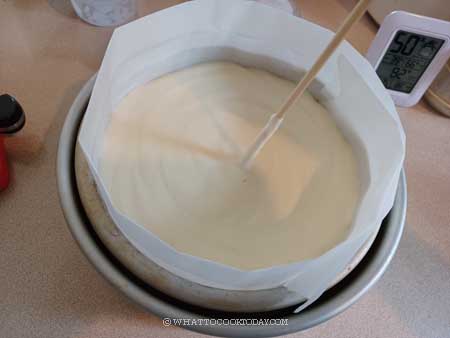
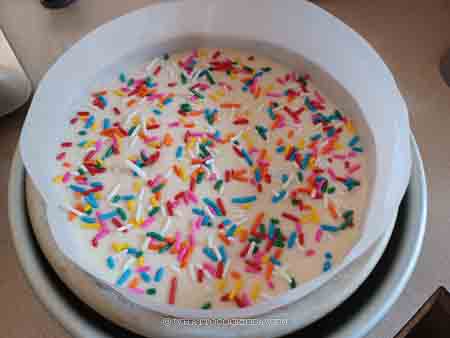
12. Then gently pour the rest of the batter on top. Use a skewer to go round and round the top portion of the batter, trying not to disturb the chocolate sprinkle layer beneath it. Top with chocolate sprinkle on the surface. Then tap the pan on the countertop 2-3 times to pop more air bubbles

13. Carefully put this pan inside the larger pan. The water inside of the pan should be simmering as it has been preheated. Close the door and set timer to 20 minutes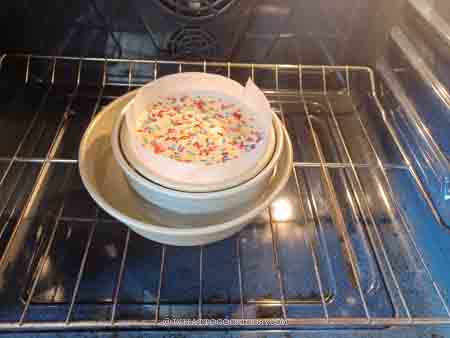
14. Increase temperature to 170 C (330 F). For top and bottom heat oven adjust to 150 F. Set the timer to 15 minutes. You don’t need to wait until it reaches the newly set temperature to start the timer. I kept monitoring its progress during this 15 minutes. This is the time where the cake starts to rise. If you start seeing some cracks are about to form, the oven is too hot. Open the oven door for about 10 seconds to release some pressure and close it back. If during that 15 minutes the cake still has a smooth top, then there’s no need to open the oven door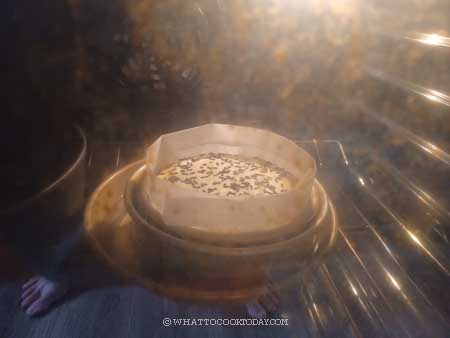
15. Lower temperature to 120 C (250 F). For top and bottom heat oven adjust to 110 C (230 F). Open the oven door for 10 seconds and then gently close it back and set the timer to 60 minutes. You may not need 60 minutes. You can start checking at around 40 minutes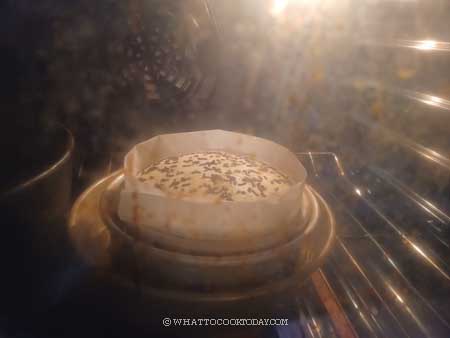
16. Increase temperature to 150 C (300 F) and bake for another 10 minutes. This part is to brown the top of the cake. If yours is already brown, you can skip this part. Mine was still pretty pale at the end of the 50 minutes of baking. So I need a total of about 100 minutes to bake this cake. It could be different with your oven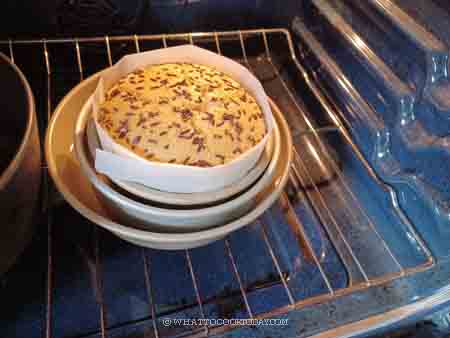
17. Turn off the oven and open the door for 10 seconds and then close it back and let the cake cools in the oven for 10 minutes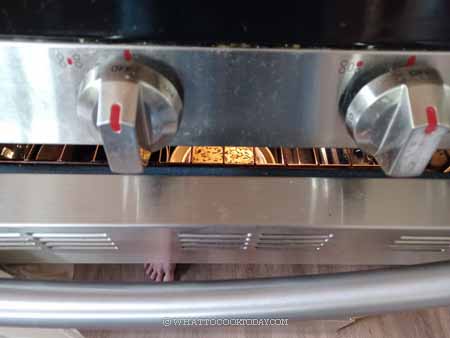
18. Remove from the oven and let it sits on the counter for another 10 minutes. I started to unmould the cake by pushing up the cake (I use a loose-bottom pan). If you use a regular pan, trim off the excess paper on top and then invert the cake upside down on a cooling rack or a plate. 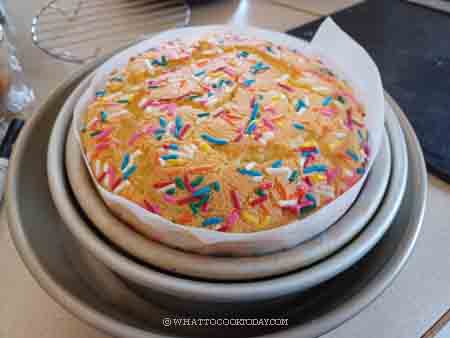
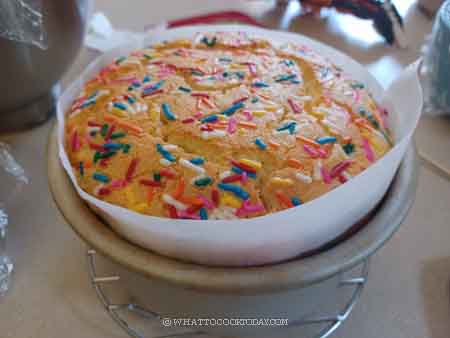
19. Peel off the parchment paper at the bottom and the side. Flip the cake back onto a serving platter and let it cools down completely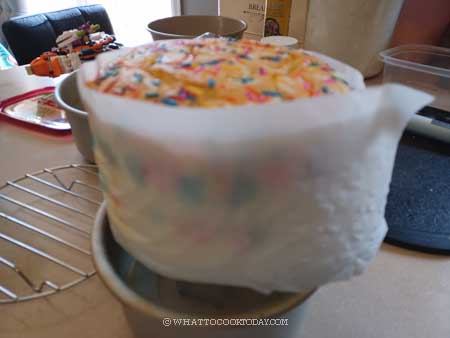
20. There will be a small amount of shrinkage, about 1/2 inch, in my case, if the cake is perfectly baked. When you gently pat the cake on the side while it’s still warm, the cake will jiggle. Once it cools down completely and set, it won’t jiggle anymore and it is normal
21. This cake needs to be chilled before serving for the best taste and texture. Let the cake cool down completely at room temperature and then put in the fridge for at least 8 hours before serving

Did you make this yogurt souffle cake recipe?
I love it when you guys snap a photo and tag to show me what you’ve made Simply tag me @WhatToCookToday #WhatToCookToday on Instagram and I’ll be sure to stop by and take a peek for real!



